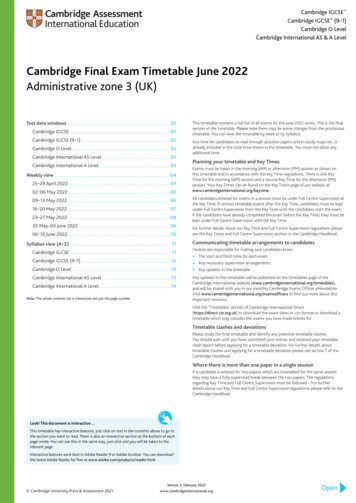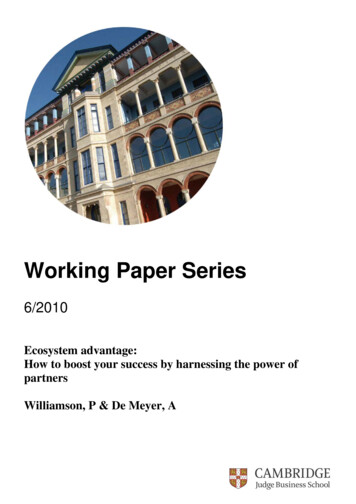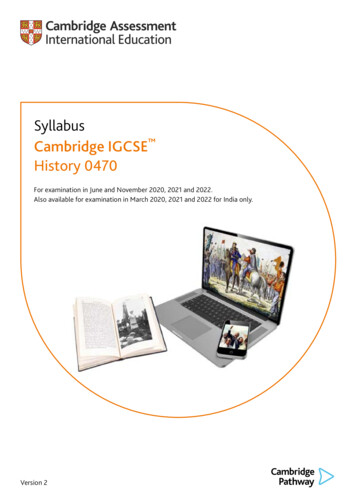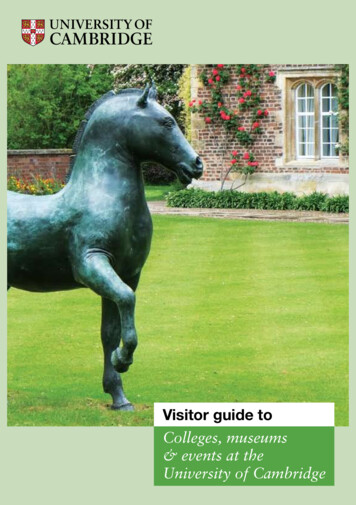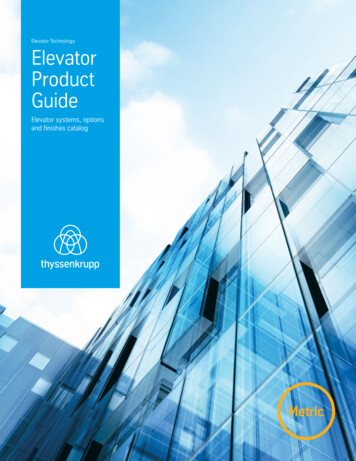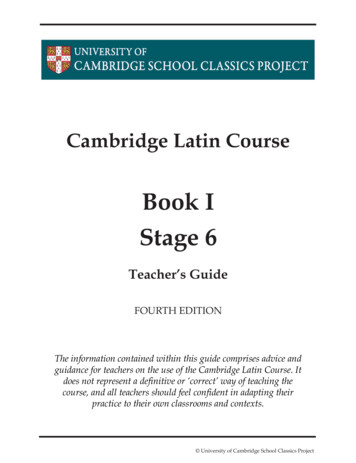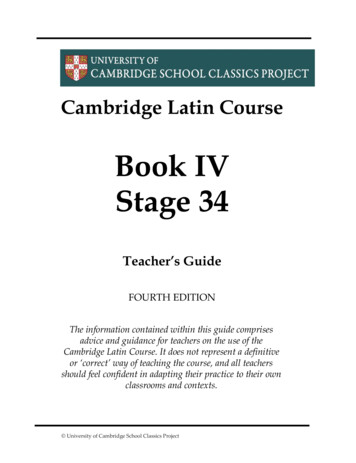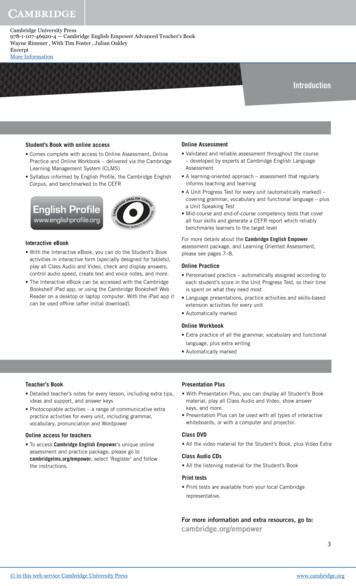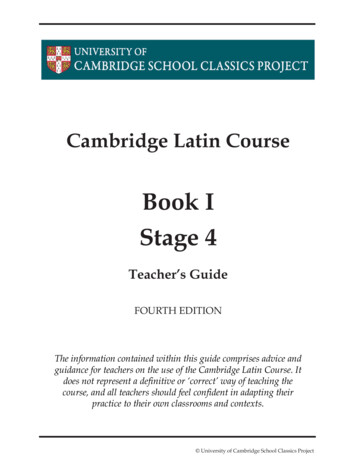
Transcription
Cambridge Latin CourseBook IStage 4Teacher’s GuideFOURTH EDITIONThe information contained within this guide comprises advice andguidance for teachers on the use of the Cambridge Latin Course. Itdoes not represent a definitive or ‘correct’ way of teaching thecourse, and all teachers should feel confident in adapting theirpractice to their own classrooms and contexts. University of Cambridge School Classics Project
Faculty of Education,184 Hills Road,CambridgeCB2 8PQThis book, an outcome of work jointly commissioned by the Schools Councilbefore its closure and the Cambridge School Classics Project and is publishedwith the kind permission of the Department for Education and CambridgeUniversity Press. University of Cambridge School Classics ProjectIn the case of this publication the CSCP is waiving normal copyrightprovisions in that copies of this material may be made free of charge andwithout specific permission so long as they are for educational and notcommercial use. Any material that is used should be attributed to the CSCPclearly and prominently.First published 1970Second edition 1982Third edition 1999This edition 2019Produced for digital publication via www.cambridgescp.comThe CSCP has no responsibility for the persistence or accuracy of URLs forexternal or third-party internet websites referred to in this publication, anddoes not guarantee that any content on such websites is, or will remain,accurate or appropriate. Information regarding prices, travel timetables andother factual information given in this work is correct atthe time of first printing but Cambridge University Press does not guaranteethe accuracy of such information thereafter.Layout by Newton Harris Design PartnershipIllustrations by Kathy Baxendale University of Cambridge School Classics Project
STAGE 4 in forōCulturalbackgroundStory lineMain languagefeaturesThe forum atPompeii;finance andthe lawcourts.Caecilius lendsmoney to a Greekmerchant,Hermogenes; hedoes not repay thedebt and is taken tocourt by Caecilius.1st and 2ndperson singularpresent, includingsum, es.Focus of exercisesSelection of suitableverb in 1st or 2ndperson singular.Story for translation.Opening page (p. 39)Illustration. View of forum seen through arch on eastern side of Temple of Jupiter(opposite view from that on p. 28). Part of the temple can be seen on the right. The brickbuildings at the far end are the municipal offices. In the foreground, two stone blocksprevent wheeled traffic from entering the forum. The arch which frames the picture ismade of brick-faced concrete but was originally faced with marble.Model sentences (pp. 40–2)New language feature. The 1st and 2nd person singular of the present tense. Familiarcharacters state in the 1st person who they are and what they are doing. They thenanswer questions posed to them in the 2nd person.New vocabulary. ego, tū, quid, quis.First reading. This presents little difficulty because the pictures give strong clues andthere is little new vocabulary. Suggested procedure:1. Teacher reads Grumio’s statement (1) in Latin.2. Teacher says, ‘Grumio is speaking. What does he say?’ If necessary, act out thestatement, emphasising ego.3. Encourage use of the immediate present, e.g. What are you selling? (10), rather thanWhat do you sell?4. After the meaning has been elicited, give other parts to individuals or groups. Askthem to read each pair of sentences aloud in Latin and then translate.Note. ego and tū have been inserted in these sentences to aid students. They aregradually phased out in the Stages which follow.Consolidation. A mime game is useful here. Students take it in turns to mime actions andthe class guesses who they are or what they are doing (e.g. tū es poēta or tū versumrecitās). If the class cannot guess, the student has to tell them (e.g. ego sum poēta or egoversum recitō). University of Cambridge School Classics Project
Hermogenēs (p. 43)Story. Caecilius lends money to Hermogenes, a Greek merchant. He requires thetransaction to be recorded on a wax tablet with the imprint of the merchant’s seal.Hermogenes does not repay the loan.First reading. Read the story at one sitting, leaving students eager to find out whathappens next.The 1st and 2nd person singular crop up naturally in the dialogue. Any further commenton the language should be postponed until study of the language note. If ego pecūniamquaerō (line 5) causes difficulty, remind students that when Caecilius went to the port tosee Syphax (p. 31) we were told Caecilius servum quaerit. A reminder of the context of aword’s previous occurrence is far more effective than looking up the word in the generalvocabulary.At the end of the story invite speculation about what will happen in court. In order torespond, and to understand the implications of what Caecilius says in line 10 (ego cēramhabeō. tū ānulum habēs?), students will need to know about the Roman practice ofrecording business transactions on wax tablets. See ‘Further information’ below.Consolidation. Follow up with a dramatic reading, or recapitulate when introducing thenext story, or postpone consolidation until in basilicā has been read and the incident canbe dramatised in its entirety.Further information. Seals were commonly carried as rings, as illustrated on p. 44. Waxtablets recording business transactions (illustrated on pp. 9 and 47) were usually boundtogether in a set of three (i.e. six sides) as follows:Front cover. Plain wood with title inscribed in ink.Sides 2 and 3. Agreement or receipt in full, engraved in wax.Side 4.XXXSpecial leaf for signatures, with a fairly wide groove down the centre. The twotablets were tied together down the middle with string, and fastened along thegroove with wax. The participants and witnesses would each press their seal intothe wax and sign their name across the leaf, using both sides of the groove. In theillustration above, X represents the seal. University of Cambridge School Classics Project
Side 5. Summary, giving brief details and names from the main text, possibly forreference, to enable the main text to remain sealed, or in case of loss.Back cover. Usually plain wood. The complete triptych was then bound round theoutside.Caecilius’ surviving business records, the main source for our knowledge about him, areof this type.Illustration. Looking towards the arch where the previous photograph (p. 39) was taken.In front of the row of shops stood a colonnade which was roofed to give protection fromthe sun. The row of pedestals inside the colonnade would have supported statues ofprominent citizens. The columns have been partly reconstructed in brickwork in moderntimes.in basilicā (p. 44)Play. Caecilius takes Hermogenes to court and wins his case on the evidence of the waxtablet and the signet ring.First reading. Set the scene and establish the court procedures by asking comprehensionquestions on lines 2–11. Then tell students to explore the meaning in groups of five inpreparation for assuming the characters of narrator, judge, Caecilius, Hermogenes andhis friend.Check students’ understanding of the meaning and help them to envisage the scene andreflect on the characters by asking, e.g.:What do you think Caecilius does at line 26?Why does Hermogenes say ēheu! in line 27? How loudly do you think he says it?What is Hermogenes doing in line 29 when Caecilius says ecce!? Why? What doesthe judge do in line 30 before saying ānulus rem probat?Consolidation. Once students have an understanding of the story, draw attention to theillustrations of the basilica (p. 46), and the trial and writing tablet (p. 47).Paired groups could then perform the play, one in English, followed by one in Latin. Therest of the class could supply the reactions of the onlookers in court. A final versioncould be recorded on tape or video.Worksheet Master 4.3, which provides a check on students’ grasp of the story, could be setfor homework. University of Cambridge School Classics Project
Illustrationsp. 44 Clockwise from left:Enlarged image of peridot (semi-precious stone) seal engraved with horse(Cambridge, Fitzwilliam Museum).Seal ring made in gold without jewels (Victoria and Albert Museum).An amethyst with Medusa’s head (British Museum).A cornelian showing Hygeia, goddess of health (British Museum).An onyx showing a warship (British Museum).About the language (p. 45)New language feature. 1st and 2nd person singular of the present tense.Discussion. Ask students what they have noticed in the model sentences. Most willmention ego and tū; some will have spotted the new verb endings. See what progressthey make with the formulation of rules; then proceed with the language note.Consolidation. Follow the initial reading with oral practice of other familiar verbs. Retainego and tū, or use a noun as subject, for the time being. When students appear confident,follow up with further oral practice in the 1st and 2nd person with the subject omitted.Practising the language (pp. 46–7)Exercise 1. Selection of suitable verb to match the subject in 1st or 2nd person.**Exercise 2. Story. Grumio comes home drunk and is frightened by the mural of a lion inthe dining-room.Illustrationsp. 46 As can be seen from the air photograph on p. 51 of Book I, the basilica was vast. Itsroof timbers were supported on 28 brick pillars surrounding the central space. Likethe walls, these were covered in stucco and painted to look like marble. Therectangular object is the base of an equestrian statue.p. 47 Detail of a painting from Pompeii which shows the judgment of Solomon or aparallel story. Two soldiers watch as a woman kneels before a judge on thetribunal. On either side of him is an adviser. (Naples, Archaeological Museum)Wax tablet as described above (Naples, Archaeological Museum). University of Cambridge School Classics Project
Cultural background material (pp. 48–51)Content. The physical appearance of the forum and the range and importance of theactivities which occurred there.Discussion. A single location for state ceremonial, law, religion, administration, businessand daily shopping will be a strange concept for many students. Discussion of thequestion, ‘Is there a modern equivalent?’ will enable them to draw on their ownexperience of village green, town market square or urban shopping precinct, and toexamine the significance of the Pompeian evidence more closely for similarities.Illustrationsp. 48 Part of colonnade on west side of forum. The lower storey is Doric, the upperIonic – which, following Greek tradition, is more slender.Line drawing based on a frieze showing scenes in the forum, found in the atriumof the house of Julia Felix. Photographs of other scenes from the same frieze areon pp. 49 and 142. (Naples, Archaeological Museum).p. 49 Equestrian statue (restored). This comes from Herculaneum. No statues were foundin the forum at Pompeii, either because they had been removed for restoration afterthe earthquake of AD 62 or because they were recovered by survivors after theeruption (Naples, Archaeological Museum).p. 50 Scroll of plant forms inhabited by birds. Fine decoration carved in marble on thedoorway of the Clothworkers’ Guildhall.p. 51 The air photograph of the forum is surrounded by details of some of the principalbuildings. The notes below are numbered to match the photograph. Those thatrefer also to the surrounding illustrations have headings printed in bold type.1. Temple of Jupiter, flanked by two triumphal arches.2. The market hall had little shops along its walls inside and out, with the fishmarket at the back. In the middle of the central court-yard were a water tank anda small structure with a domed roof.3. Temple of the Lares of Pompeii, possibly built in expiation after the earthquake ofAD 62.4. Temple of the Emperors, dedicated to the cult of the most recent emperor. At thetime of the eruption in AD 79 this was Vespasian, who had died two monthsearlier.5. Eumachia’s Clothworkers’ Guildhall. This headquarters of the guild of fullers(cleaners of cloth) had been donated by a wealthy priestess called Eumachia. Thisguild may have been the largest business group in the town and was prominentin local politics. No fewer than 24 electoral notices for AD 79 mention a fuller.6. Polling station, situated at the end of the Via dell’ Abbondanza. Voting in themunicipal elections took place here. University of Cambridge School Classics Project
7. The municipal offices were occupied by the duoviri, the aediles and thedecurions, or council, with their staff of clerks and officials. In front of the officeswas a colonnade, shown in the picture. (Local government is discussed in Stage11.)8. The basilica was not only the courthouse but also a financial centre forbusinessmen.9. Temple of Apollo, where Apollo and Diana were worshipped. The cella wasraised on a high podium in the central courtyard, with an altar at the foot of thesteps and a sundial on a pedestal at one side. The statue of Apollo (a copy)originally held a bow.10. On the outside wall of this temple under the portico, there was a recess whichcontained the weights and measures table. Cut into the stone slab was a series ofcavities of different sizes in which purchasers could measure the grain orfoodstuffs they had bought to ensure that they had been sold the correct quantity.The cavities had holes in the bottom to allow foodstuffs to be collected easily.p. 52 Detail of carving on lararium from Caecilius’ house showing a scene during theearthquake of AD 62. The Temple of Jupiter has an altar in front of it and equestrianstatues on either side. The artist has shown only four of the six columns whichformed the colonnade at the front of the temple. The scene may commemorate thesurvival of the family in the earthquake.Suggested activities1. Worksheet Masters 4.4 and 4.6 are straightforward and focus on the forum.2. Construct a frieze of the forum as a pedestrian precinct surrounded by colonnadesand buildings. Different groups could be allocated different areas and use slides,information from later Stages, and further research to complete the task over aperiod of time.3. Exercises in historical empathy (e.g. written account, recording on tape or video,dramatic presentation) could develop the characters, e.g. Clemens bargaining forfood in the forum, or Caecilius negotiating a business deal in the Clothworkers’Guildhall. University of Cambridge School Classics Project
University of Cambridge School Classics Project
Cambridge Latin Course . Book I . Stage 4 . Teacher's Guide . FOURTH EDITION . The information contained within this guide comprises advice and guidance for teachers on the use of the Cambridge Latin Course. It does not represent a definitive or 'correct' way of teaching the course, and all teachers should feel confident in adapting their

